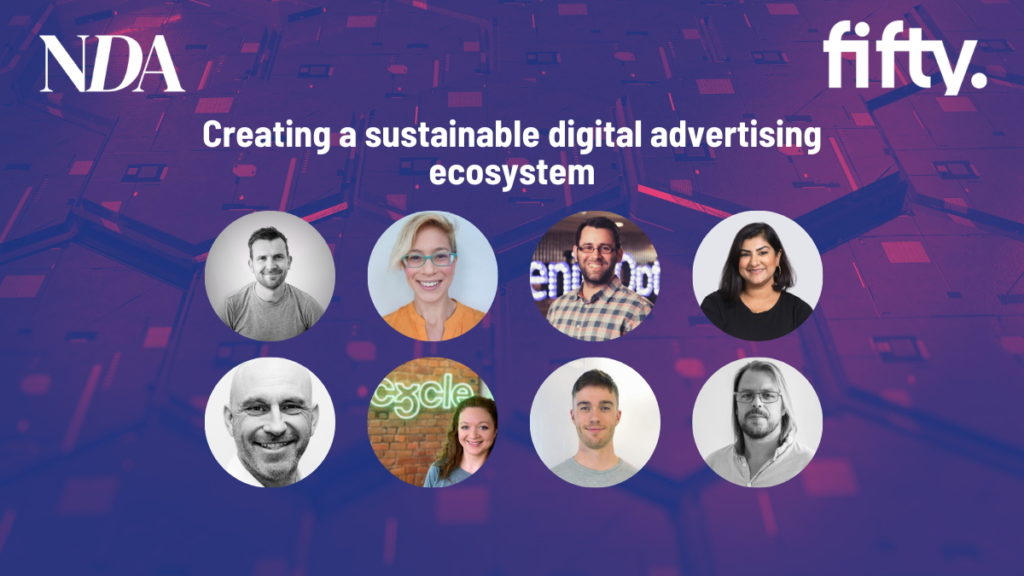Sustainability means different things to different people, but we can all agree it’s important in some way. The two definitions offered up by Oxford Languages are: the ability to be maintained at a certain rate or level; and avoidance of the depletion of natural resources in order to maintain an ecological balance. But what does that mean to digital advertising? And where do the industry’s priorities lie?
In the second part of our roundtable, in partnership with Fifty.io, the focus was very much on the issue of sustainability. Discussing the challenge were Steve Taylor, Joint Chief Strategy Officer at VCCP Media; Gabriella Krite, Head of Digital Operations at The Kite Factory; Tim Jones, Head of Digital Delivery at The Specialist Works; Leena Vara-Patel, Managing Director at 13minutes, The7Stars’ business acceleration consultancy; Guillermo Dvorak, Head of Digital at Total Media; Alex Wood, MX Business Director at Bicycle London; Alex Hawkesworth, Head of Product at Fifty; and Simon Eaton, Managing Director at Fifty.
“In adtech, we’ve never positioned ourselves as being environmentally friendly or ethical. Whereas, now, the first slide of a pitch deck will say that we’re privacy-first and as sustainable as humanly possible,” Fifty’s Eaton said, describing the challenge that companies face in the current environment.
However, the general consensus is that many brands aren’t necessarily showing any real desire to see a more sustainable advertising process, because it doesn’t make any sense to them from a business standpoint.
“They’ve got a number to get to at the end of the day,” said The Kite Factory’s Krite. “We work with marketing teams with targets. While we can provide the information to guide their footprint decisions and they may morally want to buy into a cohesive, sustainable environment, ultimately, it’s their job on the line if they don’t achieve their targets.”
For The Specialist Works, this is reflected in the fact that there is only one client on the agency’s roster that is showing a strong desire for sustainable advertising, according to Jones. He shared: “We have a client who is committed to being one of the most sustainable high street retailers in the UK, and they are keen to see that through to their ad tech selection. They’re really the only ones that we’ve spoken to that are currently showing interest though.”
13minutes’ Vara-Patel puts the lack of a sustainability push from brands when it comes to advertising down to marketing being “really far removed” from the world. It’s difficult for changes to be actioned and for brands to understand the full extent of the damage their marketing could be doing.
“They get it from a corporate social responsibility point of view, but the way that translates into how we operate from a marketing perspective is very different,” explained Vara-Patel. “I liken it to watching Frozen Planet 2. You can understand that and see what’s happening, but how do I actually make that change? There’s a little bit of a disconnect there.”
Taylor from VCCP Media agrees, feeling it’s very difficult to illustrate to people how their digital advertising is doing damage, because nobody can directly see the impact being made.
“It’s quite abstract to understand how it’s environmentally better to do things. It’s so far removed,” he said. “It’s very difficult to imagine servers in a server farm doing slightly less, or having one less server and that making an impact. Whereas, if you tell people that you’re going to do their out-of-home advertising on compostable paper, it’s tangible.”
Making the change
Total Media’s Dvorak believes that the responsibility to make changes is on the tech companies, which hold much more power and influence than the agencies and brands when it comes to creating a sustainable advertising ecosystem.
“The big changes will have to happen at the tech server side. We are just agencies and brands,” said Dvorak. “If Disney, Netflix, Apple, and whoever else want to keep building those walled gardens, that means we have to keep duplicating who we target. I could be reaching the same person 15 times through different platforms, and that’s a problem all-round.”
On the other hand, Wood of Bicycle London feels that agencies could be taking more responsibility for their role in creating an unsustainable ecosystem, pointing to the fee models they utilise.
“If agencies moved more toward fee models that aren’t dependent on encouraging the client to spend more – potentially unnecessary – money on media, clients appreciate that and it’s more environmentally friendly. We shouldn’t be trying to get brands to run more activity when sometimes it’s not adding incremental revenue,” Wood said.
Whatever the solution to the industry’s sustainability issues, Fifty’s Hawkesworth is ‘terrified’ by the amount of carbon emissions produced by the digital advertising industry, but knows nothing is going to change unless the money begins to flow in a different direction.
“Our industry is thought to be contributing about 2% of carbon emissions globally, which is a terrifying number,” he shared. “It feels like the problem is that, because it’s not economically viable, we’re not going to follow it. Everybody is expecting somebody else to solve the problem. And we can’t find a solution, because everything is where the money flows.
“It’s very similar to fraud within the industry. The incentive isn’t there for everybody to cut off their noses to spite their faces.”











